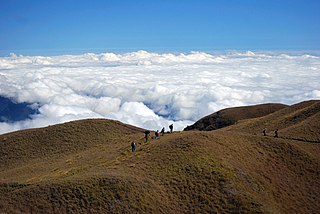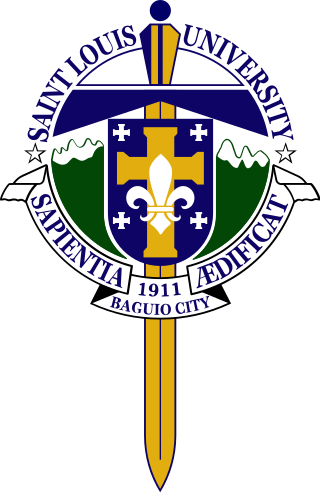
Baguio, officially the City of Baguio, is a 1st class highly urbanized city in the Cordillera Administrative Region, Philippines. It is known as the "Summer Capital of the Philippines", owing to its cool climate since the city is located approximately 4,810 feet above mean sea level, often cited as 1,540 meters in the Luzon tropical pine forests ecoregion, which also makes it conducive for the growth of mossy plants, orchids and pine trees, to which it attributes its other moniker as the "City of Pines".

Benguet, officially the Province of Benguet, is a landlocked province of the Philippines located in the southern tip of the Cordillera Administrative Region in the island of Luzon. Its capital is La Trinidad.

The Cordillera Administrative Region, also known as the Cordillera Region and Cordillera, is an administrative region in the Philippines, situated within the island of Luzon. It is the only landlocked region in the insular country, bordered by the Ilocos Region to the west and southwest, and by the Cagayan Valley Region to the north, east, and southeast. It is the least populous region in the Philippines, with a population less than that of the city of Manila.

La Trinidad, officially the Municipality of La Trinidad, is a 1st class municipality and capital of the province of Benguet, Philippines. According to the 2020 census, it has a population of 137,404 people.

Buguias, officially the Municipality of Buguias,, is a 3rd class municipality in the province of Benguet, Philippines. According to the 2020 census, it has a population of 44,877 people. The municipality is home to the mummy of Apo Anno, one of the most revered and important folk hero in Benguet prior to Spanish arrival.

Itogon, officially the Municipality of Itogon,, is a 1st class municipality in the province of Benguet, Philippines. According to the 2020 census, it has a population of 61,498 people.

Tuba, officially the Municipality of Tuba,, is a 1st class municipality in the province of Benguet, Philippines. According to the 2020 census, it has a population of 48,312 people.

Saint Louis University also referred to by its acronym SLU, is a private Catholic research basic and higher education institution run by the Congregation of the Immaculate Heart of Mary in Baguio, Philippines. It was founded on December 1, 1911, by the CICM Missionaries.

The Department of Education is the executive department of the Philippine government responsible for ensuring access to, promoting equity in, and improving the quality of basic education. It is the main agency tasked to manage and govern the Philippine system of basic education. It is the chief formulator of Philippine education policy and responsible for the Philippine primary and secondary school systems. It has its headquarters at the DepEd Complex in Meralco Avenue, Pasig.
Education in the Philippines is compulsory at the basic education level, composed of kindergarten, elementary school, junior high school, and senior high school. The educational system is managed by three government agencies by level of education: the Department of Education (DepEd) for basic education; the Commission on Higher Education (CHED) for higher education; and the Technical Education and Skills Development Authority (TESDA) for technical and vocational education. Public education is funded by the national government.
The University of the Cordilleras, formerly known as the Baguio Colleges Foundation (BCF), is a private coeducational university in Baguio, Philippines. Founded by Benjamin R. Salvosa and his wife Evangelina D. Salvosa in 1946, it offers programs at the elementary, secondary, undergraduate and graduate levels catering to around 21,000 students.
Cordillera Regional Science High School (CRSHS) is a public high school located in La Trinidad, Benguet, Philippines. It serves as the campus of the Regional Science High School Union system for the Cordillera Administrative Region.
The Student Technologists and Entrepreneurs of the Philippines is an organization formed by the consolidation of the former Future Farmers of the Philippines (FFP), Future Homemakers of the Philippines (FHP) and Future Agricultural Homemakers of the Philippines (FAHP) organizations. Its membership is composed mainly of high school students and out-of-school-youth (OSY).

The Palarong Pambansa is an annual multi-sport event involving student-athletes from 17 regions of the Philippines. The event, started in 1948, is organized and governed by the Department of Education.

The University of Baguio, formerly Baguio Technical and Commercial Institute, is a private, Filipino, multidisciplinary, autonomous university in Baguio, Philippines. It was founded by Fernando Gonzaga Bautista and Rosa Castillo Bautista on August 8, 1948, with 80 students. The student population in 2018 was about 18,000 in its tertiary level.

The Philippine Military Academy also referred to by its acronym PMA is the premier military academy for Filipinos aspiring for a commission as a military officer of the Armed Forces of the Philippines (AFP). It was established on December 21, 1936, by the virtue of National Defense Act of 1935. It is patterned after the United States Military Academy, in West Point, New York. The academy is located in the city of Baguio, and serves as the primary training school for future officers of the AFP.

The Baguio City Heritage Hill and Nature Park is an abandoned structure atop Dominican Hill, Baguio, Philippines. The local government initiated rehabilitation efforts, which was started in April 2022, through a 15 million Philippine pesos grant from the National Commission for Culture and the Arts. The whole property on which it stands has been renamed as the Dominican Heritage Hill and Nature Park. A panoramic view of the city unfolds from its vantage point, the stone crucifix on the outdoor patio of the hotel's second floor.

The COVID-19 pandemic in the Cordillera Administrative Region is part of the worldwide pandemic of coronavirus disease 2019 caused by severe acute respiratory syndrome coronavirus 2. The virus reached the Cordillera Administrative Region on March 20, 2020, when the first case of the disease was confirmed to involve a resident of Manabo, Abra. All provinces, as well as the independent city of Baguio has recorded at least one confirmed COVID-19 case.



















